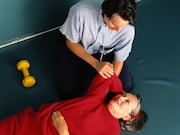Two-Thirds of Sunscreens Fail Safety Tests
More than 60 percent of products do not provide adequate sun protection, contain potentially harmful chemicals
Use of Rehab After Ischemic Stroke Varies in Acute Care
Some stroke patients less likely to get rehabilitation services due to patient, hospital variables
Worldwide Prevalence of Eating Disorders Increased Since 2000
Point prevalence for eating disorders increased during the study period from 2000-2006 to 2013-2018
CDC: Racial Disparity Seen With Lupus-Related Deaths
Deaths among blacks occur sooner after diagnosis and at younger age compared with whites
Light, Incremental Physical Activity Can Help Reduce Brain Aging
Each additional hour spent in light-intensity physical activity equivalent to about 1.1 years less brain aging
Late-Onset Type 1 Diabetes Often Misdiagnosed as Type 2
Almost one-third of people older than 30 when first diagnosed with type 2 diabetes have type 1
U.S. Prevalence of Alcoholic Fatty Liver Disease Stable at 4.7 Percent
But prevalence of AFLD with stage 2 or greater fibrosis, AFLD with stage 3 or greater fibrosis increased
Home-Based Cardiac Rehab May Be Option for Some Heart Patients
Short-term clinical outcomes improved similarly for home-based, center-based cardiac rehabilitation
Herpes Zoster Ophthalmicus Cases Increased in 2004 to 2012
Highest rates of HZO seen in older adults, women, and in whites versus other racial groups
Some Cervical Cancer Screening Strategies More Cost-Effective
Most lifetime QALYs seen with cytologic testing every three years, repeated for ASC-US



















